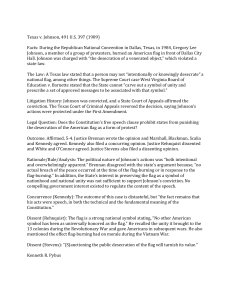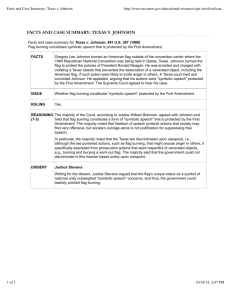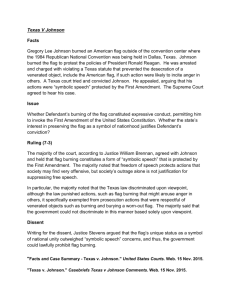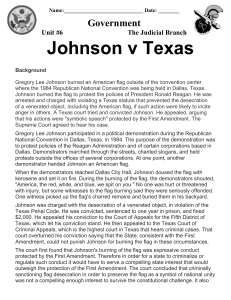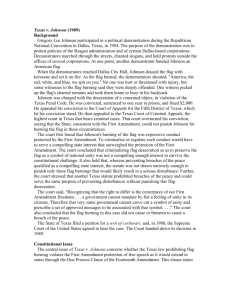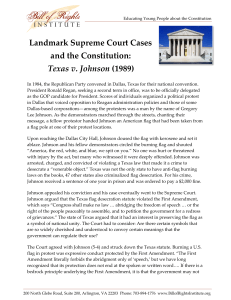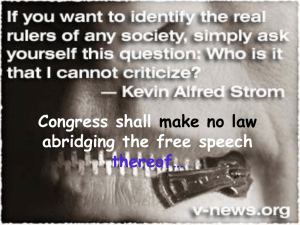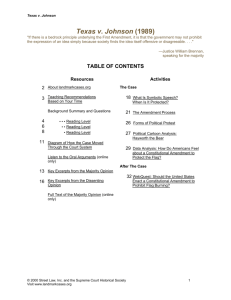BACKGROUND: Gregory Lee Johnson participated in a political
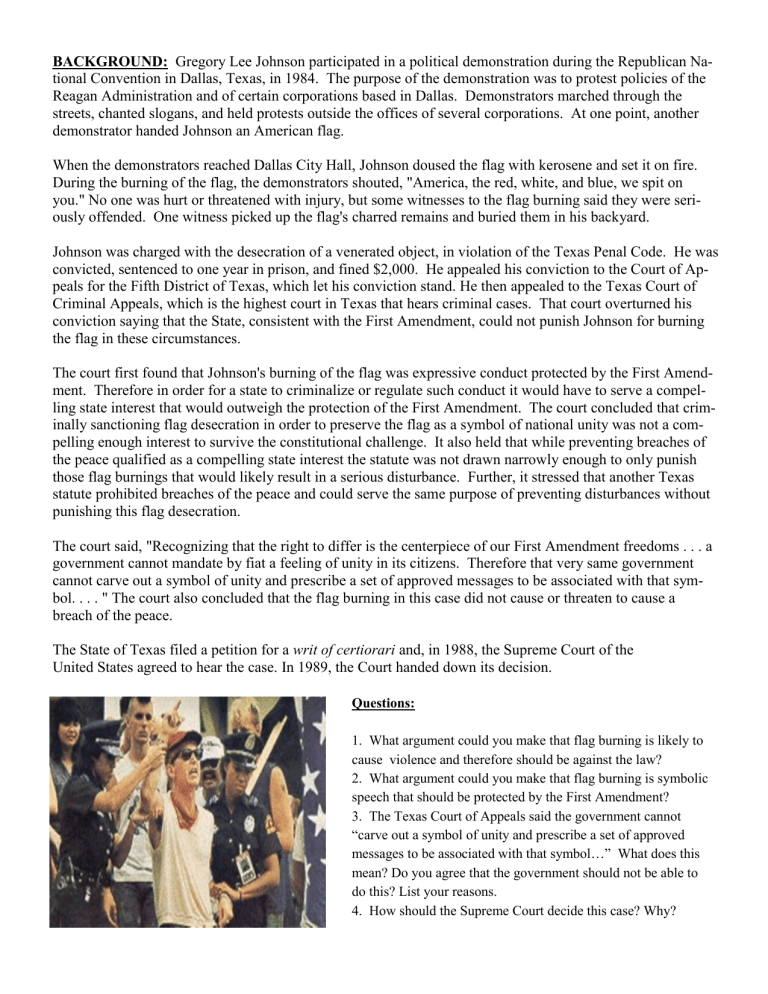
BACKGROUND: Gregory Lee Johnson participated in a political demonstration during the Republican National Convention in Dallas, Texas, in 1984. The purpose of the demonstration was to protest policies of the
Reagan Administration and of certain corporations based in Dallas. Demonstrators marched through the streets, chanted slogans, and held protests outside the offices of several corporations. At one point, another demonstrator handed Johnson an American flag.
When the demonstrators reached Dallas City Hall, Johnson doused the flag with kerosene and set it on fire.
During the burning of the flag, the demonstrators shouted, "America, the red, white, and blue, we spit on you." No one was hurt or threatened with injury, but some witnesses to the flag burning said they were seriously offended. One witness picked up the flag's charred remains and buried them in his backyard.
Johnson was charged with the desecration of a venerated object, in violation of the Texas Penal Code. He was convicted, sentenced to one year in prison, and fined $2,000. He appealed his conviction to the Court of Appeals for the Fifth District of Texas, which let his conviction stand. He then appealed to the Texas Court of
Criminal Appeals, which is the highest court in Texas that hears criminal cases. That court overturned his conviction saying that the State, consistent with the First Amendment, could not punish Johnson for burning the flag in these circumstances.
The court first found that Johnson's burning of the flag was expressive conduct protected by the First Amendment. Therefore in order for a state to criminalize or regulate such conduct it would have to serve a compelling state interest that would outweigh the protection of the First Amendment. The court concluded that criminally sanctioning flag desecration in order to preserve the flag as a symbol of national unity was not a compelling enough interest to survive the constitutional challenge. It also held that while preventing breaches of the peace qualified as a compelling state interest the statute was not drawn narrowly enough to only punish those flag burnings that would likely result in a serious disturbance. Further, it stressed that another Texas statute prohibited breaches of the peace and could serve the same purpose of preventing disturbances without punishing this flag desecration.
The court said, "Recognizing that the right to differ is the centerpiece of our First Amendment freedoms . . . a government cannot mandate by fiat a feeling of unity in its citizens. Therefore that very same government cannot carve out a symbol of unity and prescribe a set of approved messages to be associated with that symbol. . . . " The court also concluded that the flag burning in this case did not cause or threaten to cause a breach of the peace.
The State of Texas filed a petition for a writ of certiorari and, in 1988, the Supreme Court of the
United States agreed to hear the case. In 1989, the Court handed down its decision.
Questions:
1. What argument could you make that flag burning is likely to cause violence and therefore should be against the law?
2. What argument could you make that flag burning is symbolic speech that should be protected by the First Amendment?
3. The Texas Court of Appeals said the government cannot
“carve out a symbol of unity and prescribe a set of approved messages to be associated with that symbol…” What does this mean? Do you agree that the government should not be able to do this? List your reasons.
4. How should the Supreme Court decide this case? Why?
Questions:
5. According to this opinion, why does the First Amendment protect the flag burning in which Johnson was engaged?
6. According to the Court, Texas asserted an interest in preserving the flag symbol of national unity. How does the
Court respond to this assertion?
7. Why does the Court say that the flag’s position as a symbol will be strengthened , not weakened, by their decision in this case?
8. How does the Court recommend that supporters of the flag respond to those who desecrate it?
9. Do you agree the majority opinion? Why or why not?
Questions:
10. Chief Justice Rehnquist agrees with the majority that expression may not be punished because of the negative reaction of people who observe that expression. What does he say is the real justification for anti-flag burning laws and why Johnson should be punished?
11. In Chief Justice Rehnquist’s opinion, how was the unique status that the flag enjoys established?
12. What point is Chief Justice Rehnquist trying to make about flag burning when he mentions that the government may send young men into battle to die for the flag, but may not prohibit the public burning of the flag? Do you agree or disagree with this argument? Explain.
